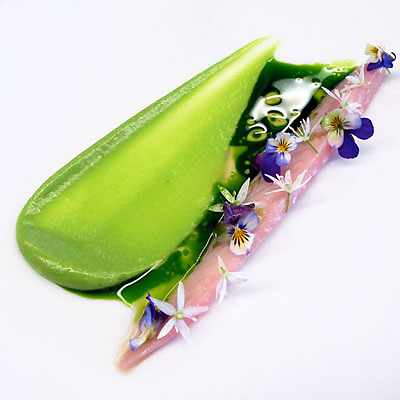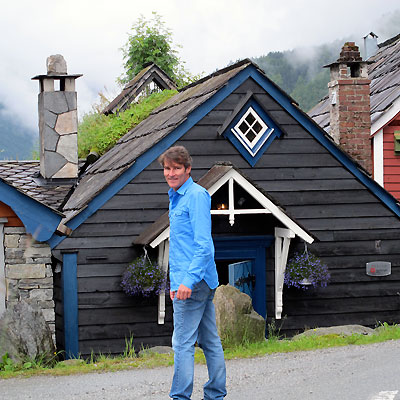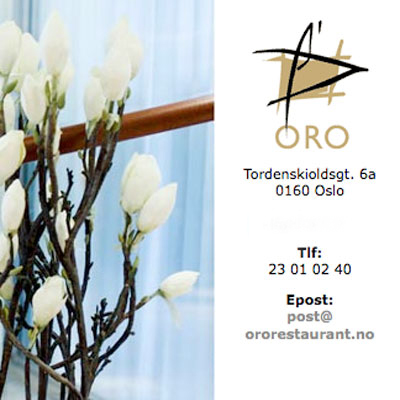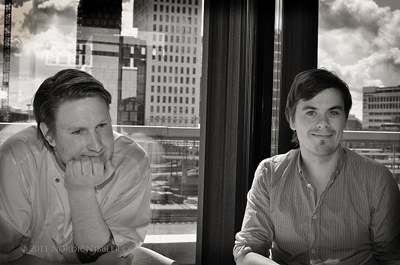
When fellow food blogger Greg Henry, who writes the SippitySup blog, announced he’d be visiting Norway at the request of the Norwegian Travel Bureau, and asked if I’d be interested in writing a guest post for his blog I jumped at the chance. I had mentioned a new Oslo gourmet restaurant to him that I had been to a couple of times. The restaurant had opened a few months previously and serves only organic produce that originates almost exclusively from Norway, something that has never been attempted before. I had been utterly wowed by the food I tasted there, so we struck upon the idea of me interviewing some of the people behind it to hear their story of how this restaurant came to be and a bit about their philosophy. Maaemo’s Esben Holmboe Bang (l) & Pontus Dahlström ®
The story of Norway’s most exciting restaurant starts, rather mundanely, at an office Christmas party in 2009. But this was to be no ordinary Christmas party. Gathered together was the staff of Kolonihagen, a café and supplier of organic produce in Oslo run by Jon-Frede Engdahl, a charismatic Norwegian entrepreneur. At the party, Engdahl stood up and gave a speech in which he revealed an interesting fact: the folks at a certain French tyre company had mentioned that there were no Michelin-starred restaurants serving entirely organic produce. The gauntlet had been thrown down and Engdahl’s interest was piqued.
Listening to this speech, and liking what he heard, was the husband of one of the Kolonihagen staff members: a young and ambitious Danish chef called Esben Holmboe Bang. The chef had learnt his craft at some of the most prestigious restaurants in Norway and Denmark and was now looking for a new challenge. Together with Pontus Dahlström, a Finn and one of the most talented sommeliers and front of house managers working in Norway, the trio would embark upon a remarkable project: Maaemo.
Maaemo – “Mother Earth” in old Finnish – opened its doors to the public in December 2010. The statistics alone make for fascinating reading: Maaemo uses 100% organic, biodynamic, or wild produce, of which 95% comes from Norway, and 85% of which is sourced from less than 60 miles or so from Oslo. I have had the good fortune to eat a couple of times at Maaemo since it opened (see my reviews of the winter menu here and the spring menu here) and both times I was blown away by the experience. This really is cooking of the very highest level; intelligent, skilled, creative, even witty at times. Norway has seen nothing like it, and just six months into this project it already feels like Maaemo is forging a new and exciting path for Norwegian cuisine.
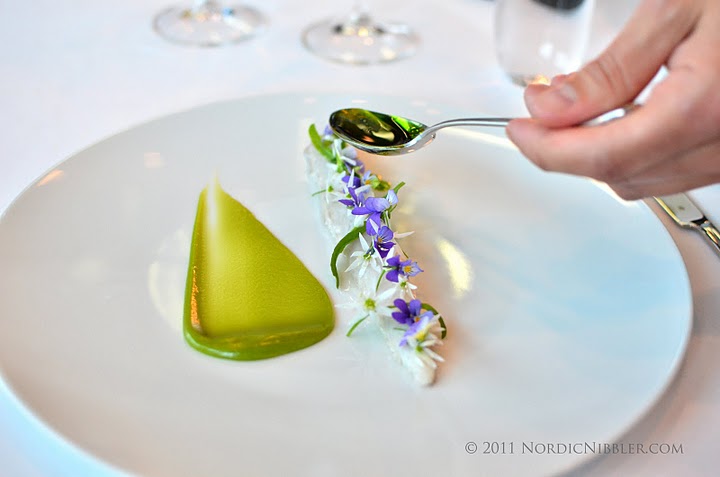 So it was that fellow food blogger Greg Henry and I came to be at Maaemo to speak with two thirds of the founding team. We’re ushered up to the kitchen with views across the city skyline, where chef Esben Holmboe Bang is eager to make one of the dishes from Maaemo’s spring menu for us: Ramsløk & Makrell (left). You can get the recipe for the dish & see a video of its preparation on Sippity Sup.
So it was that fellow food blogger Greg Henry and I came to be at Maaemo to speak with two thirds of the founding team. We’re ushered up to the kitchen with views across the city skyline, where chef Esben Holmboe Bang is eager to make one of the dishes from Maaemo’s spring menu for us: Ramsløk & Makrell (left). You can get the recipe for the dish & see a video of its preparation on Sippity Sup.
Esben Holmboe Bang & Pontus Dahlström
Not yet 30, Esben looks boyishly young, yet he comes across as unnaturally self-assured and passionate about his style of cooking. For him, the ingredients are everything and he strives to pay them respect by treating them as gently and honestly as possible. We are also joined by Pontus Dahlström who is Maaemo’s sommelier and runs the front of house. Having eaten at Maaemo, one thing I’m struck by is the unusually complementary roles the wines have to play and Dahlström is the driving force behind this.
Nordic Nibbler: Tell me how you both (Esben Holmboe Bang & Pontus Dahlström) came to be involved with the Maaemo project?
Esben Holmboe Bang: It happened at a Christmas party two years ago. My wife worked with Jon-Frede (Engdahl) at Kolonihagen and Jon-Frede was giving a speech in which he said that he talked to Michelin and found out there were no organic Michelin-starred restaurants – there were restaurants using organic produce, but there were none using it 100% – and that it was his dream to create one.
So Jon-Frede and I sat down and had a talk about this. I’m really excited by organic and bio-dynamic produce and we were talking loosely about whether we could do something together, and as it became more and more concrete what it was we were going to do we had to get some wine people involved.
I didn’t know Pontus at that time. We had met through a friend one or two times but we didn’t know each other personally. I was eating at Bagatelle (a former two-start restaurant in Oslo) back in the really old days when Pontus was running the restaurant, and I always thought he was the perfect Maître d’ and sommelier. So I said if we’re going to talk to someone we have to speak with Pontus. So we got in contact through a friend and he came on board quite early on.
Pontus Dahlström: And the thing was we really agreed on everything. (For me) it all started with organic produce when I had my first daughter. I was raised in the 1980’s with microwave ovens and industrial food, so for me it’s maybe too late, but I want to give my daughter the best possible food there is.
When I came on board in mid-January, I had been talking with a lot of different projects about starting something, but the ambition level wasn’t there. And here we really started off with (the attitude that) “we’re going to do this without compromising”. Jon-Frede asked us at the second or third meeting, “what about doing it (organic produce) only 90%”. We both said that it wouldn’t be interesting at all. If we’re going to do this it has to be a challenge, it has to do something for Norwegian food, and also make farmers produce better products.
EHB: There was a long prepping period before opening Maaemo. We looked at a lot of locations and spaces, and we had to meet a lot of suppliers, so the whole networking aspect was very important in order to get in touch with the farmers. And the farmers at first were kind of negative actually. They said, “OK you’re opening a small restaurant, but that doesn’t make a difference to us”.
Now it’s OK because the farmers see they get a lot of media coverage from us, but at first it was really hard to get the produce for the restaurant.
PD: It was easier to get wine from the best small wineries from all over the world than it was to get a farmer 100km from here to send kale to us down here in Oslo.
So you were not only creating your own restaurant but having to educate people about the sort of produce you wanted?
EHB: Yes, almost. And we got educated also! When you work in a restaurant the easiest thing should be to find produce; farmers are calling you and you just fill out a form and the goods are sent the next day. But here it’s really hard; I have to order one week in advance and we have to go and pick it up. It’s fun though, it’s really fun. I have personal contact with all the farmers and we visit them and talk to them often.
PD: We started up in the winter (December 2010), so we didn’t have a huge selection of produce available. In January (2010) Esben sat down with a few of the best suppliers and started to plan to get the right product when we wanted it, in the right amount and size, and with the best flavours.
EHB: The farmers now are testing produce for us, and a lot of the produce we’re getting now is stuff that we’ve asked them to grow. So there’s a more personal feel now, and that’s a strength of Maaemo, that we have this personal contact with our suppliers.
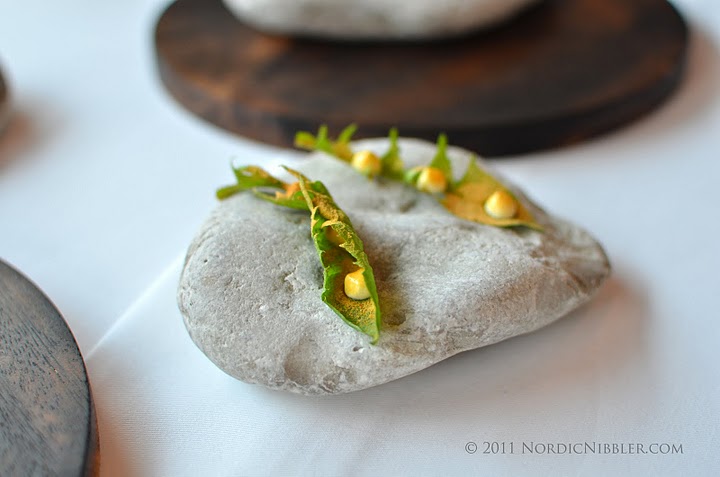 Maaemo is certainly very different to any restaurant I’ve been to anywhere. How did you expect the Norwegian public to react to what you were trying to achieve?
Maaemo is certainly very different to any restaurant I’ve been to anywhere. How did you expect the Norwegian public to react to what you were trying to achieve?
EHB: We were thinking that it’s going to be hard. In Norway I think people generally don’t like it when people have ambition. It’s quite difficult for a restaurant to say they want to be the best. So we were humble and said we’re going to do the best we can, and in general the public responded positively and we got some good press. But we still hear people saying, “oh, they’re just going to do another Noma”. So quite early on we said we wouldn’t talk about Noma. They can do what they do and we’ll do what we do. (Dandelion leaves and sour cream from Røros- above)
The real challenge was the organic produce because people in Norway don’t have a very good relationship with organic food. Organic has a bit of a bad name in Norway; people avoid it in the supermarket saying it’s too expensive or too snobby. So we wanted people to understand that we were dong this (organic produce) to give them the best possible experience. We use organic because it is the best. Bottom line.
But we were thinking that it’s going to be a challenge.
PD: And it still is; we don’t have 50 people on the waiting list every night. It’s an expensive country to start up a restaurant and it’s tough; we’re never going to get rich from this. But that’s not the goal either; the goal is to be the best in our own way. And of course we respect the people doing other cuisine, but we have to find our own way and do as well as possible for our guests, that’s the goal.
I think it’s fair to say there isn’t a big dining out culture here in Norway; eating out is expensive and people tend to do it for the one-off big events like birthdays or anniversaries or corporate dinners. And then, maybe people would traditionally expect things like foie gras and a big piece of meat with sauce and potatoes. So was it hard for you guys to go against this grain somewhat?
EHB: The best thing for us is to showcase the best Norwegian ingredients and be as respectful as we can to those ingredients. But yes, that was one of the challenges. We have some vegetarian dishes and some people asked, “where’s the meat and potatoes and sauce”? We had one famous Norwegian chef, I’m not going to say who, who came in and he said, “but you have to have some sauce, where’s the sauce?”
PD: We want to have a relaxed ambience in the restaurant. For example, we are 100% organic but we only mention this once when we present the menu. We really want to explain the story behind each course. We try to educate people in a nice way; we don’t want them to feel we are talking down to them. We want to give guests something to think about while they are eating.
EHB: It’s better now; more people know a bit more about what we are trying to do. Nine out of ten nights we have people with cameras taking pictures. We’re in a food blogger era now, and sometimes we can follow service on Twitter and say “oh, table 7 liked this”. But it’s fun because people take it more seriously. They come in for an experience and they expect to think about the food and get involved with the food.
Would you ever go down the route of growing your own produce?
EHB: Yes, we may get a small allotment. So we’re hopefully going to start producing soon.
PD: In the future that’s really the goal: to have full control (of the produce) from the beginning to the end.
EHB: It’s life. Food is life and everything we get in here is alive or has been alive at some point. So it’s about making sure you respect that. The best way of ensuring that everything we use has had a good life is by growing it ourselves, that way we know all our standards have been fulfilled.
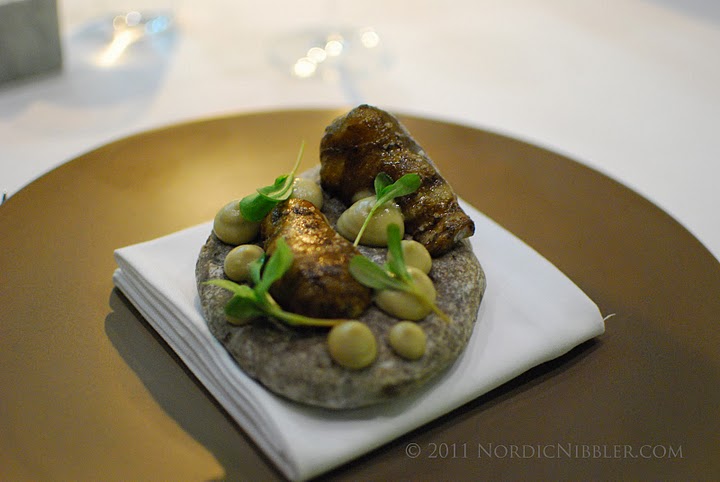 EHB: The farmers have a profound respect for what they do, and when you meet them and talk to them you get a lot of respect for them. In the end you reflect that on the plate as you don’t want to mess it up.
EHB: The farmers have a profound respect for what they do, and when you meet them and talk to them you get a lot of respect for them. In the end you reflect that on the plate as you don’t want to mess it up.
We have a Jerusalem artichoke dish (left), and Else, (Else Skålvoll Thorenfeldt from Korsvold Farm) who produces these artichokes for us, puts out blankets at night in the winter so the ground doesn’t freeze, and she gets up early the next day to pick these small artichokes for us. There’s a lot of work going into it. So when a chef makes a mistake I don’t get angry, I just get sad. So there’s a lot of respect for produce at Maaemo, that’s the most important thing.
It strikes me that you’re remarkably young, Esben, yet you seem to have a great maturity in wanting to treat the ingredients as honestly as possible. Inevitably there will be comparisons made with Noma. How would you describe your cooking style and what have your influences been?
EHB: I don’t know actually! I got a lot from Denmark. I worked in Copenhagen, and the food scene there evolved really quickly and there was a lot of stuff going on. Not so much in Norway. When I first came to Norway I was kind of disappointed because I thought I was coming to the country with the best produce. And I just saw imported French produce in all the fine dining restaurants. And I got really disappointed. So quite early on I said I’m going to learn as much as possible in the fine dining restaurants in Oslo, but this is not for me. I always want when I cook for it to be as natural as possible and I want the reference point to be when the produce is in nature, because that’s when it tastes the best. When you take fresh herbs in the forest and you eat it there it has a clear flavour and is pure. Everything else that happens on the way to the plate just dilutes the flavour.
So I don’t know how to describe the cooking style, but of course it is Scandinavian cooking. It is a part of the “New Nordic” thing, but still it’s personal cuisine and it’s hard to label it because we cook from the heart here and we want the flavours to be as clear as possible, no dilution, really clean flavours.
Of course, inspiration-wise (it’s) the whole “New Nordic” movement. Before Noma there were a lot of restaurants doing similar food in Denmark. Of course, Noma got a lot of hype and press, but I think there were and are small restaurants in Copenhagen that are serving really good “New Nordic” cuisine.
PD: It was interesting reading the introduction to his (René Redzepi’s) book. He mentions all the things that went through his head when he started to make, for example, Scandinavian stock and he didn’t get it to work out and had to rethink everything. Of course, it takes time to find your identity and he has started something like Paul Bocuse did in the 1960’s with “Nouvelle Cuisine” or El Bulli in the 1980’s; he started it all. But today there are a lot of people making their own way.
EHB: He (Redzepi) started something, but today there are branches coming out and people are establishing themselves in interpreting Scandinavian cuisine. So that’s what we’re doing; we are interpreting Norwegian nature and Norwegian produce. I don’t think we are there yet at all. We are starting to get a style and an identity but it’s still a process. We have only been open half a year, but it’s coming.
PD: Our goal is to give the taste and flavour and ambience of the nature that surrounds us. Which means the Oslo Fjord, Nordmarka Forest just above us, and all these things. That’s the goal. I am not a native Norwegian, Esben isn’t and none of the chefs are. So we see things our own way, a little bit like tourists. We’re really trying to find our own way and what Norway really is in our eyes.
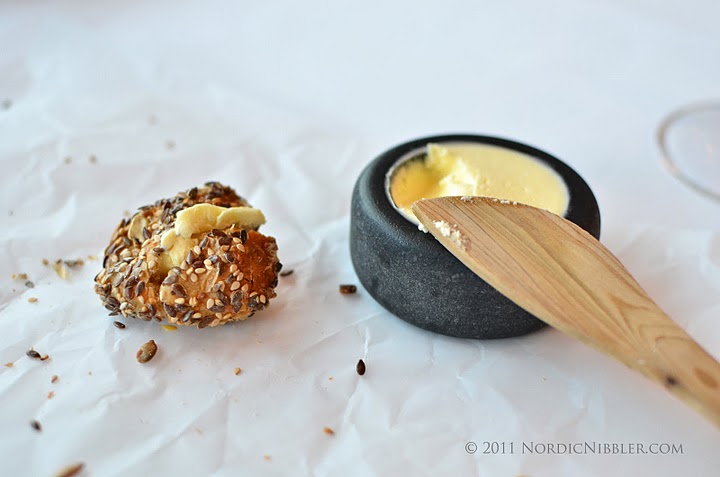 EHB: There’s a lot of teamwork at Maaemo. We’re all quite young here and there’s a drive to do something extraordinary and we work really hard everyday to give the best possible experience. We feel like there’s something going on but we don’t quite know what it is or where it’s going to end. But there is something special here and everybody is sharing this feeling so it’s a remarkable place to work because everybody is just pushing really hard. Now we get international chefs coming here to work, so there is something going on and it’s really, really fun to a part of it. (Bread with Røros butter served on matpapir- left)
EHB: There’s a lot of teamwork at Maaemo. We’re all quite young here and there’s a drive to do something extraordinary and we work really hard everyday to give the best possible experience. We feel like there’s something going on but we don’t quite know what it is or where it’s going to end. But there is something special here and everybody is sharing this feeling so it’s a remarkable place to work because everybody is just pushing really hard. Now we get international chefs coming here to work, so there is something going on and it’s really, really fun to a part of it. (Bread with Røros butter served on matpapir- left)
PD: Our goal is to get better; this service has to be better than the last, with everything we do – it’s the way we walk, it’s the way we talk, it’s the way we treat the vegetables, everything. As long as we can keep that momentum in the restaurant then we will bring the restaurant forward and give a better experience to our guests. That’s what it’s all about basically.
You speak about teamwork. Tell me a bit about the collaborative process works in terms of recipe development; how do you research ideas? Also the wine menu here seems extraordinarily well-matched with the food, how do you come up with that remarkable pairing of food and wine?
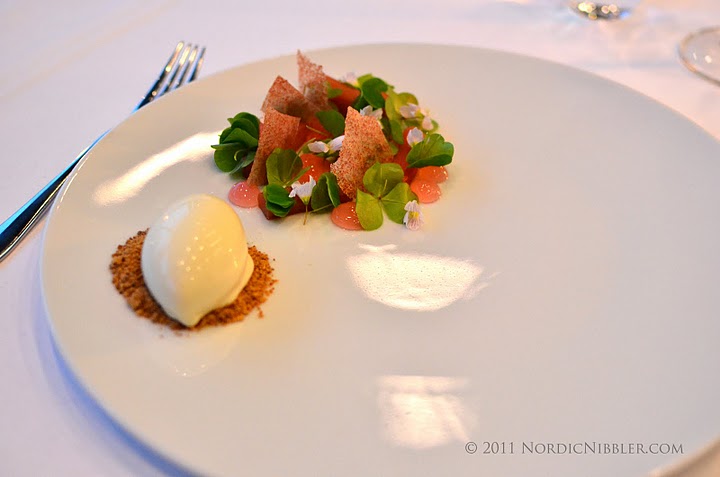 EHB: It often starts in the kitchen with just an idea. For example we have a new rhubarb dish that came on a couple of weeks ago. We were thinking we wanted to do something with rhubarb and milk (left). I wanted to make an ice cream that had a clean milk flavour with almost no added sugar and we were thinking (about it). I said to the chefs that we had to think about making an ice cream with no added sugar. We tested a lot and we tried to reduce the milk. In the end one of the chefs came up with the idea that we had to do it in a vacuum for a long time. So we had the ovens set at different temperatures, and for maybe a week we put milk in every night and tasted it afterwards and measured its sugar content. In the end we found the perfect temperature that was high enough to let the natural sugar almost caramelise so it gave texture to the ice cream while keeping a clean milk flavour. And then we just worked from there. We got the milk and then we thought about how to get a clean rhubarb flavour with it. It takes anywhere from 2 days to 2 months. Quite early on I pitched the idea to Pontus so he could start with the wine.
EHB: It often starts in the kitchen with just an idea. For example we have a new rhubarb dish that came on a couple of weeks ago. We were thinking we wanted to do something with rhubarb and milk (left). I wanted to make an ice cream that had a clean milk flavour with almost no added sugar and we were thinking (about it). I said to the chefs that we had to think about making an ice cream with no added sugar. We tested a lot and we tried to reduce the milk. In the end one of the chefs came up with the idea that we had to do it in a vacuum for a long time. So we had the ovens set at different temperatures, and for maybe a week we put milk in every night and tasted it afterwards and measured its sugar content. In the end we found the perfect temperature that was high enough to let the natural sugar almost caramelise so it gave texture to the ice cream while keeping a clean milk flavour. And then we just worked from there. We got the milk and then we thought about how to get a clean rhubarb flavour with it. It takes anywhere from 2 days to 2 months. Quite early on I pitched the idea to Pontus so he could start with the wine.
PD: We sit down and he gives me ideas on paper. He paints the dish and describes what will be in it, and then I start to think flavours. With the way we work here it’s quite difficult sometimes. For example with the sea kale dish, that’s the base of the dish, I’ve never worked with that before, what do we do? So we have courses that we have tested over 40 wines with before we are satisfied. When we start to think wine, the most important thing is respect for the food. So I’m always thinking about intensity. How much flavour? We have a balance to strike and I want the wine to be just below the food (in intensity) yet bring something to the course. So with the rhubarb dish, for example, we serve a strange wine. It’s a Moscata Rosa, which is really floral, so it goes with the harmony of flavours but it’s less intense, and the floral flavours give an extra dimension to the course. And that’s really what food and wine is about.
In Scandinavia, we don’t have a history of pairing wine with food. If you go to Burgundy and serve something other than a red Burgundy with your Coq au Vin they will shoot you around the corner when it gets dark! Up here we can do whatever we want. That’s what I try to think about: to give the unexpected to the guest and to have the wine bring something to the dish. And it’s really, really hard. I’m maybe totally satisfied with 30% of the wine pairings. But there are limitations; even though we have 14,500 wines available in Norway, it is not enough to create a perfect pairing with every dish.
EHB: One of the things that has always surprised me is how a lot of chefs, when they make dish, will say “now it’s finished, now it’s perfect”. And they say to the sommelier, “find a wine for this”. And that (approach) doesn’t work. We have to have respect for each other. When I feel that a dish is finished, it’s not finished until the combination (with the wine) is there. That’s really important for us because people come in and they pay a lot of money to sit down and have a perfect combination, so we have to work together to give our guests the best possible food-wine pairing. I think Pontus is one of the best sommeliers there is right now and you have to have respect for each other.
PD: In terms of respect, it’s really about everybody that works here. We have people that have been working for low wages and working for free in some of the best restaurants who now work for us. If we don’t respect them we don’t get good employees, and if we don’t get good employees we can’t operate at the level we want.
It seems like a very Scandinavian trait to have this mutual respect and understanding, unlike in many other kitchens where you have a very hierarchical, almost dictatorial, structure.
PD: I cleaned the toilets before you came! I’m not better than others here; without them I’m nothing. I can’t run the restaurant alone. Ultimately I think this (attitude) is one of our strengths and gives a better result for the guests.
EHB: Everything we do here, and this is what we say to all new staff, leads up to the point where the guest walks in the door and the experience starts. Everything has to be 100% – and that’s how you come in in the morning, how you hang up your clothes when you change into your chef’s whites – otherwise you don’t give the guests the best experience.
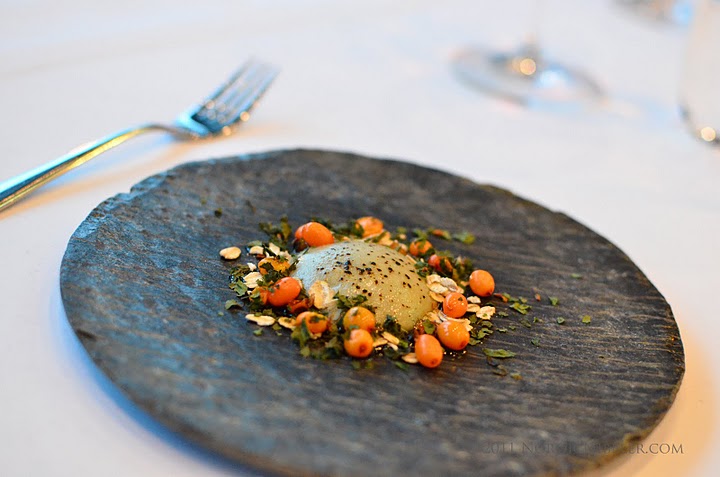 What ambitions do you have for Maaemo? Where would you like the restaurant to be going forward? Do you have global ambitions to turn Maaemo into a food destination in its own right?
What ambitions do you have for Maaemo? Where would you like the restaurant to be going forward? Do you have global ambitions to turn Maaemo into a food destination in its own right?
EHB: It’s a balance, because you can’t think about it too much. Of course, we have ambitions and that is to be the best we can be, and then we’ll see what happens. But you can’t say, “yeah, I want two stars”. Everyday has to be better than the day before and then we’ll see what happens.
But if you want to survive in this business then you have to have some international renown because there are not enough people dining out in Norway. You have to have tourists coming in. So of course, our goal is try and get Maaemo as (well known) as we can. (Cheese from Eggen dairy eith seabuckthorn, oats and maple- above)
Now we have more people coming, and it’s nice to see Norwegians appreciating what we are doing. That’s been the main objective because we are making Norwegian food with Norwegian produce, so it warms the heart if Norwegians like it.
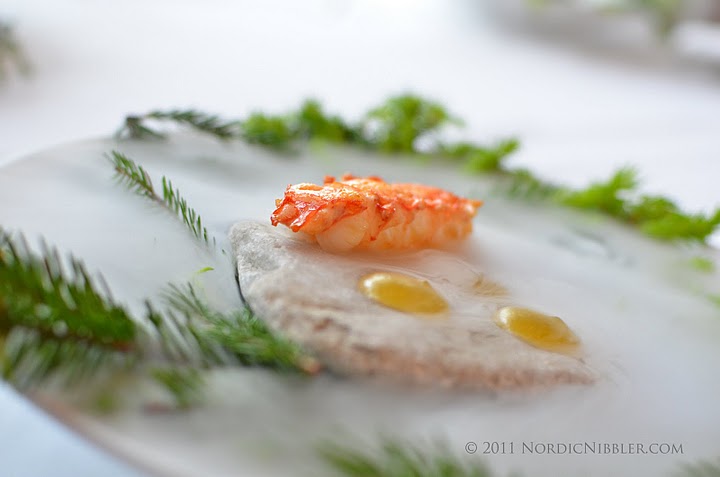 Moving on, if there was one Norwegian ingredient you’d like the world to know about, what would that be?
Moving on, if there was one Norwegian ingredient you’d like the world to know about, what would that be?
EHB: (Jokingly) Jarlsberg! No, I think seafood, of course: Norwegian scallops, langoustines, and lobsters are magnificent. When I worked in Denmark we didn’t get live scallops. Noma was the first to get live scallops. So when we get them here and you take them out of their shells and they’re still twitching because they’re so fresh, it’s magnificent. (Norwegian langoustine and pine- right)
PD: I think seafood, too. But also, as I’m born and raised in Finland where we don’t have a tradition for lamb, the lamb here in Norway, especially from the high mountains, has a fantastic flavour because of what they eat.
EHB: And berries! Because we have low temperatures here they get longer growing time so they develop a sweetness that is just magnificent. There’s just so much to say actually.
PD: There are a lot of things. But it’s really due to the climate – the cold waters and weather – flavours need time to develop. We are in a really unique place here in the world.
EHB: It’s magnificent – by far the best produce – and it’s really, really fun to live by the seasons.
Please stop by www.NordicNibbler.com for more terrific insights on Norwegian food including Esben Holmboe Bang & Pontus Dahlström. GREG
Esben Holmboe Bang & Pontus Dahlström
